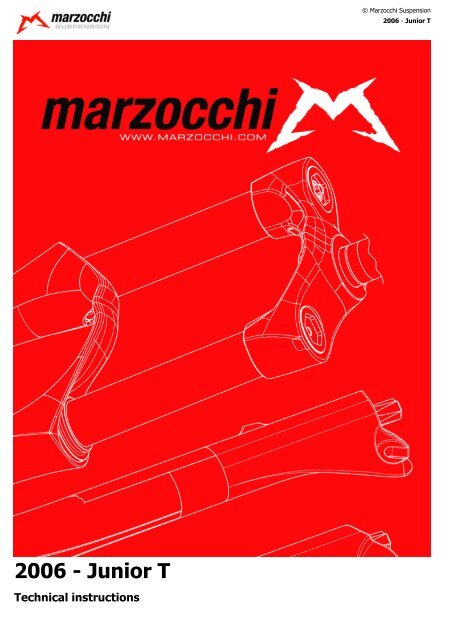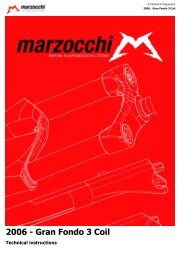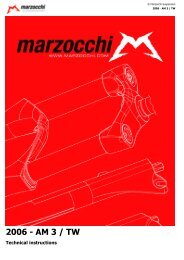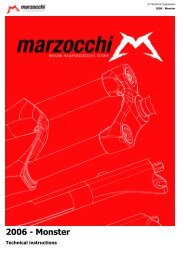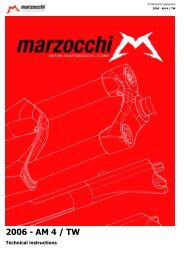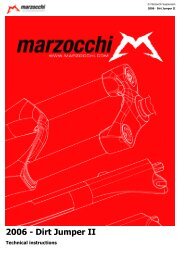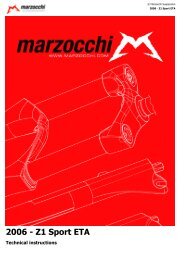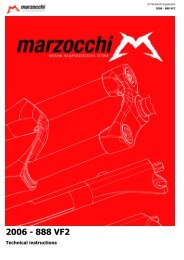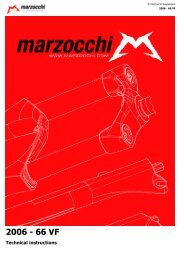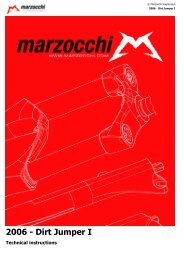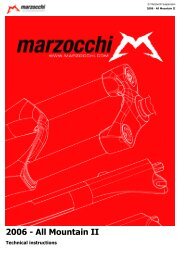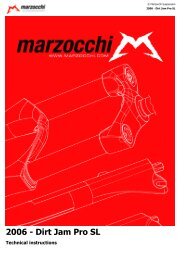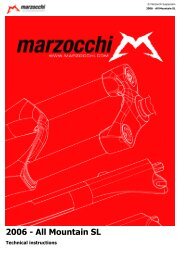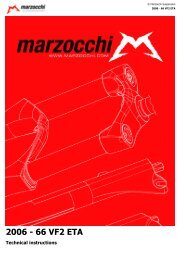2006 - Junior T
2006 - Junior T
2006 - Junior T
- No tags were found...
You also want an ePaper? Increase the reach of your titles
YUMPU automatically turns print PDFs into web optimized ePapers that Google loves.
© Marzocchi Suspension<strong>2006</strong> - <strong>Junior</strong> T52 520344PN SCREW 455 850760/C FENDER UNIT 156 526143RX FENDER BUSHINGS 257 520342AR FENDER SCREW 259 547705 ALLOY STEM -LABELS 1
© Marzocchi Suspension<strong>2006</strong> - <strong>Junior</strong> TExploded view - <strong>Junior</strong> T - TARif. Code Quantity1 549062LA 22 520263AA 23 523299CD 24 528226 25 701228/C 26 532826 27 528214 28 5321132AC>A 29 522387 410 520341 111 5321153>A 112 533297 213 523261 214 528230>A 215 538115 216 538114 219 5321261SU/R>A 119 5321261SV/R>A 119 5321261RS/R>A 119 5321261RR/R>A 119 5321261ST/R>A 119 5321261TI/R>A 119 5321261SR/R>A 120 547720 120 547725 122 528046 223 5321130>B 227 524177 228 8031529/C 229 5141131/C 130 805013 231 512105 232 5181226 233 5141264/C 134 531061 235 5141272/C 136 520178PN 537 501496LA 138 507667/C 239 7051173 139 7051174 140 502558LA 150 523300 251 522403>A 252 520344PN 455 850760/C 156 526143RX 257 520342AR 259 547705 160 526145>A 262 850777/C 163 520349LA 1<strong>Junior</strong> T - TA - Oil levelsPosition Oil type Quantity (cc)Right fork leg SAE 7,5 - 550013 260Left fork leg SAE 7,5 - 550013 260
© Marzocchi Suspension<strong>2006</strong> - <strong>Junior</strong> TSpare part list - <strong>Junior</strong> T - TARif. Code DescriptionQ.ty in themodel1 549062LA PRE LOAD KNOB- BLACK 22 520263AA ALLEN BOLT 23 523299CD STOP RING 24 528226 O-RING 25 701228/C PLUG UNIT 26 532826 EXTERNAL PRELOAD ADJUSTER 27 528214 O-RING 28 5321132AC>A EXTERNAL PRELOAD ADJUSTER 29 522387 WASHER 410 520341 SCREW 111 5321153>A CABLE GUIDE 112 533297 DUST SEAL DIA.32 213 523261 STOP RING 214 528230>A OIL SEAL DIA.32 215 538115 UPPER BUSHING DIA.32 216 538114 LOWER BUSHING DIA.32 219 5321261SU/R>A ANTI RADAR GREEN-TA MONOL.UNIT 119 5321261SV/R>A DIRT BROWN- TA MONOLITE UNIT 119 5321261RS/R>A ECO BLACK- TA MONOLITE UNIT 119 5321261RR/R>A FLAT BLACK-TA MONOLITE UNIT 119 5321261ST/R>A MAGNUM GREY FL-TA MONOL.UNIT 119 5321261TI/R>A PURE WHITE MONOLITE UNIT 119 5321261SR/R>A SILVER DUST- TA MONOLITE UNIT 120 547720 RH+LH LABELS JR.T '06-WHITE 120 547725 RH+LH LABELS JR.T GIANT '06 122 528046 O-RING 223 5321130>B FOOT NUT UNIT 227 524177 PISTON RING 228 8031529/C REBOUND ROD JR.T '06 TR.170 229 5141131/C(replaces 850272/C)REBOUND SPRING KIT 130 805013 FERRULE UNIT 231 512105 FOOT BUFFER 232 5181226 PRELOAD SLEEVE 233 5141264/C SPRINGS KIT K=9,50 DIA.32 134 531061 BUFFER JR.T 235 5141272/C SPRINGS KIT K=5,0 DIA.32 136 520178PN SCREW 537 501496LA UPPER CROWN 138 507667/C BLACK STANCHION 549,8 LONG 239 7051173 LOWER CROWN+ALLOY STEM 139 7051174 LOWER CROWN+STEEL STEM 140 502558LA LOWER CROWN 2004 150 523300 STOP RING 251 522403>A WASHER 252 520344PN SCREW 455 850760/C FENDER UNIT 156 526143RX FENDER BUSHINGS 2
© Marzocchi Suspension<strong>2006</strong> - <strong>Junior</strong> T57 520342AR FENDER SCREW 259 547705 ALLOY STEM -LABELS 160 526145>A BUSHING 262 850777/C QR 20 AXLE+SCREW KIT 163 520349LA AXLE SCREW -QR 20 1
© Marzocchi Suspension<strong>2006</strong> - <strong>Junior</strong> TTechnical characteristics: Technical characteristicsDual-crown fork with ø 32mm legs.Available travels: 170 mm.Right fork leg damping element: spring with preload mechanical adjustment.Left fork leg damping element: spring with preload mechanical adjustment.Right fork leg damping system: non-adjustable SSV pumping element.Lef fork leg damping system: non-adjustable SSV pumping element.The stanchion tubes are joined with screws to the steering crown.New sliding system to improve stiffness and operation.Lubrication and cooling of the parts subject to friction with a specially formulated oil.Steer tube: steel, 1-1/8", threadless.Crown: BAM® aluminium alloy forged and CNC machined.Top crown: aluminium alloy forged and CNC machined.Stanchions: anodised aluminium.One-piece assembly: made of magnesium alloy cast and CNC machined for lighter weight and more stiffness.Sliding bushings: made of friction-free and wear-free material.Springs: constant pitch.Seals: computer designed oil seals that guarantee maximum seal in any condition.Oil: specially formulated oil that prevents foam and keeps the viscosity unchanged while offering high performance; free from static friction.Dropout type: standard or (optional) with ø 20mm through-axle.Max wheel size: 2.8" x 26".Integrated fender: available as optional.Handlebar with direct clamp on top crown: available as option.BAM® : Bomber Aerospace Material: special alloy coming from the aerospace industry.
© Marzocchi Suspension<strong>2006</strong> - <strong>Junior</strong> TWith the fork legs at travel end, the distance between the inflated tire and the bottom of the crown must be at least 4 mm.A different position of the crowns can result in damage to the fork and in serious personal injury.Warnings: Installing the disk brakeInstalling the brake system is a delicate and critical operation that must be carried out by an authorized Marzocchi Service Center.Marzocchi is not responsible for the installation and accepts no liability for damage and/or accidents arising from this operation.Improper installation of a disk brake system can overstress the caliper mountings, which may cause the caliper mountings to break, resulting in lossof control of the bicycle, an accident, personal injury, or death. Be sure that the brake system installation is also performed in strict compliance withthe instructions provided by the brake system manufacturer.Improper installation can result in an accident, personal injury, or death.Use only brake systems that comply with the forks specifications.Make sure, after installation, that the brake cable of the brake system is correctly connectedto the proper mounting (A).The brake cable must never touch the crown and stanchions.Warnings: Assembling the fenderThe fender can be supplied with the fork or purchased separately.Fender (1) must be assembled by placing the small support bush (2) between the screw and the fenderas shown and by tightening screws (3) with an 8mm fixed spanner to the recommended tightening torque(6 Nm ±1).Warnings: Assembling the wheel on forks with standard drop-outInstall the wheel following the instructions of the manufacturer.For a correct operation of the fork, install the wheel and proceed with the following checks:Check the correct fork-wheel alignment by fully compressing the fork a few times. The wheel should not come into contact with any parts of thefork.
© Marzocchi Suspension<strong>2006</strong> - <strong>Junior</strong> TLift the front wheel above the ground; turn the wheel a few times to verify the correct alignment and the distance from the disk brake. Read theinstructions of the brake system manufacturer for the correct specifications.Warnings: Assembling the wheel on forks with ø20mm through-axleFor a correct operation of the fork, install the wheel as explained below:Align the center of the wheel with each wheel axle clamp.Insert the wheel axle (1) through the right dropout, the wheel and the left dropout.With the 6mm Allen wrench act on cap (2) and tighten the wheel axle to the recommended tighteningtorque (15 Nm ± 1).Check for the proper fork-wheel alignment. To do this, begin by fully compressing the fork a few times.The wheel should not make contact with, or come close to any portion of the fork.Then lift the front of the bicycle and spin the wheel a few times to verify the correct alignment with thedisk brake. The wheel should not wobble from side to side or up and down. Check the owner’s manual ofthe brake system for the proper specifications.With a 4mm Allen wrench, tighten the screws (3) on both dropouts to the recommended tighteningtorque (6 Nm ± 1).Warnings: Installing the handlebar mountFor a correct installation of the handlebar mount, follow the instructions below:Install the bottom handlebar mount (1) onto the top crown so that the fixing holes match.With a 5mm Allen wrench, lock the handlebar mount tightening screws (2) to the recommendedtightening torque (10 Nm ±1).Fit the handlebar right in the middle of the mount.Lock the handlebar in position with the special U-bolt (3).With a 5mm Allen wrench, tighten screws (4) to the recommended tightening torque (10 Nm ±1).
© Marzocchi Suspension<strong>2006</strong> - <strong>Junior</strong> TOn request, special adapters (5) are available to install handlebars with a different diameter.
© Marzocchi Suspension<strong>2006</strong> - <strong>Junior</strong> TDismantling: Removing the top capsPut the fork in the vice in vertical position, fixing it by the dropouts.With the 21mm socket spanner loosen the lock cap (1).Remove lock cap (1).Dismantling: Draining the oilPull the top washer (1), the preload tube (2), the top spring (3), the bottom washer (4) and the bottomspring (5) off both legs.Free the fork from the vice and tip it into a container of a suitable size to drain the oil; compress the forka few times to help the oil flow out.Do not pour used oils on the ground.Dismantling: Breaking down the steering crown unit / arch-slider assemblyUse the special spanner to remove the bottom nuts. Do not use other tools.Turn the arch-slider assembly upside down.Using the special 12mm spanner (A), loosen the bottom nuts (1) of both legs.Pull the bottom nuts (1) complete with O-rings (2) out of both legs.
© Marzocchi Suspension<strong>2006</strong> - <strong>Junior</strong> TPull the crown-stanchion unit (3) off the arch-slider assembly (4).Dismantling: Dismantling the pumping element and valveRemove the bottom pad (1).Using the special round-nose pliers, remove stop ring (2).Pull out the pumping element (3) complete with rebound spring and valve.
© Marzocchi Suspension<strong>2006</strong> - <strong>Junior</strong> TRemove the complete valve (4), the rebound spring (7) and washer (14) from the pumping element.If the piston segment (8) is damaged, you can prize it off with a small flat-tip screwdriver.Dismantling: Removing the sealsPrize the dust seal (1) off its seat with a small flat-tip screwdriver.Take great care not to damage the internal surfaces of the one-piece assembly whileremoving the dust seal.With the same screwdriver, prize off the metal stop ring (2).Take great care not to damage the internal surfaces of the one-piece assembly whileremoving the stop ring.Protect the upper part of the slider with the special tool (A).With a screwdriver, prize off the sealing ring (3).Remove the sealing ring (3).Take great care not to damage the internal surfaces of the one-piece assembly whileremoving the sealing ring.
© Marzocchi Suspension<strong>2006</strong> - <strong>Junior</strong> TRemove the spring cup (4).The old sealing rings and dust seals must not be used again.Dismantling: Removing the guide bushesUse the special extractor to remove the guide bushes. Do not use other tools.Fit the aluminium bush (A) to the extractor keeping the side with larger diameter towards the edgeopposite to striker (D).Fit the extraction washer (B) with a black finish to the extractor.During use, remove the non-used washer from the extractor.Remove first the top bushes, then the bottom bushes.Fit the extraction washer keeping the blunt side towards the threaded grubscrew (C) fixed crosswise on tothe main rod as shown.The slot in the rod lets the extraction washer swing inside the rod itself.Insert the extractor in the arch-slider assembly from the side of washer (B) as shown.The slot in the extractor rod will let the washer pass underneath the bush to be extracted.Pull the extractor rod so that the upper face of the washer stops against the lower face of the guide bush.Insert the aluminium bush (A) in the seat of the sealing ring.While holding the main rod in position, the aluminium bush will drive the guide bushes during extraction.Using striker (D) knock out and extract the guide bush (1).Remove the guide bush (1) from the extractor.Repeat the steps above to remove the bottom guide bush.
© Marzocchi Suspension<strong>2006</strong> - <strong>Junior</strong> T
© Marzocchi Suspension<strong>2006</strong> - <strong>Junior</strong> TAssembling: Assembling the guide bushesInsert the guide bushes using the special introducers (short type for the top bush and long type for the bottom bush, both with awhite finish). Do not use other tools.Fit first the bottom bushes, then the top bushes.Using the long introducer (A) fit the bottom bush (1).Using a hammer knock the introducer (A) into the arch-slider assembly.Using the short introducer (B) fit the top bush (2).Using a hammer knock the introducer (B) into the arch-slider assembly.Assembling: Assembling the sealsInsert the spring cup (4) in its seat.
© Marzocchi Suspension<strong>2006</strong> - <strong>Junior</strong> TSmear the dust seal and the sealing ring with some grease.Insert the sealing ring (3) in its seat with the special introducer (A).Using a hammer, knock in introducer (A) and drive the sealing ring home into the arch-slider assembly.Using a small flat-tip screwdriver, fit the stop ring (2) and check that it fits perfectly into its groove.Take great care not to damage the internal surfaces of the one-piece assembly when fittingthe stop ring.The dust seals shall be refitted when reassembling the crown-stanchion unit / arch-slider assembly.Assembling:During the assembly of the pumping unit, strictly obey the instructions below.Do not, at any times, reverse the position of the pumping elements in the fork legs (if you are unsure about anything, please referto the relevant exploded view).Assembling: Assembling the left pumping element and valveReplace the segment (8) of the pumping element, if necessary.Insert washer (14), the rebound spring (7) and the complete valve (4) in the piston rod.The valve unit must be placed as shown with the three-point ring towards the rebound spring.
© Marzocchi Suspension<strong>2006</strong> - <strong>Junior</strong> TInsert the pre-assembled valve in the piston rod from the three-point ring side as shown.Insert the valve and the pumping element (3) into the stanchion.Take great care not to damage the segment and if necessary use a small flat-tip screwdriver to help the piston of the pumpingelement into the stanchion.Using the special round-nose pliers, mount the stop ring (2) and check it fits perfectly into its groove.Fit the bottom pad (1) to the pumping element rod.Assembling: Reassembling the steering crown unit / arch-slider assemblyA special spanner shall be used to assemble the bottom nuts. Do not, at any times, use othertools.Fit both dust seals (11) to the stanchions.Insert the crown-stanchion unit (3) in the arch-slider assembly (4).
© Marzocchi Suspension<strong>2006</strong> - <strong>Junior</strong> TUsing the special 12mm spanner (A), tighten the bottom nuts (1) complete with O-rings (2) of both legsto the recommended tightening torque (10 Nm ± 1).Using introducer (A) insert the dust seals (11) in their seats.Assembling: Filling with oilBlock the fork in the vice, in perfectly vertical position.Lower the crown-stanchion unit on the arch-slider assembly.In a graduated recipient, prepare the quantity of oil to pour into the fork leg (see table).Pour roughly 1/3 of the oil required into each stanchion, then pump the fork a few times to eliminate anytraces of air.Pour the rest of oil in.
© Marzocchi Suspension<strong>2006</strong> - <strong>Junior</strong> TA lower or higher volume or a type of oil other than the one recommended can change the behaviour of the fork in every phase.Lift the crown-stanchion unit on the arch-slider assembly.Insert the bottom spring (5), the bottom washer (4),the top spring (3), the preload tube (2) and the topwasher (1).Assembling: Mounting the top capsPut the fork in the vice in vertical position, fixing it by the dropouts.With the 21mm socket spanner, tighten cap (1) to the recommended tightening torque (10 Nm ± 1).Restore the correct preload value, if necessary (see setting).
© Marzocchi Suspension<strong>2006</strong> - <strong>Junior</strong> TSetting: General rules for calibrationBy carefully calibrating the damping system you can get the maximum performance out of the same.This paragraph indicates the sequence of operations to perform to set up the Marzocchi forks correctly.In order to find the best settings for you, you will need to try several times to understand where and how to make adjustments. When doing so,please ride in an open area, free from traffic, obstacles and other hazards.The optimal setting is influenced by the geometry of the frame of the mountain bike, the weight of the cyclist, the type of terrain the bike will beused on and the type of obstacles you have to deal with, but also by subjective factors associated with your riding style; therefore it is impossible toprovide objective data on the desired settings.Nevertheless by carefully following the instructions below you will soon be able to find the optimal setting for you.The shock absorber must be calibrated simply by using one adjuster at a time, following the order explained, noting the operations and any resultstep-by-step.During setting don't force the adjusters beyond their limit of travel and don't exceed the max recommended air pressure.To keep the pressure inside the fork’s legs, only use the special MARZOCCHI pump with pressure gauge.The use of any other pump can compromise the inflating operation and cause malfunction or damage to the fork, resulting in anaccident, personal injury or death.Once the correct setting has been found, we recommend noting the number of clicks or turns of the adjuster with respect to the "fully closed"position (adjuster fully clockwise) for a faster re-setting of your fork in case of need.Setting: SAGSAG means the fork bottoming under the biker's weight.How to measure the SAG:Follow these simple steps to measure the SAG.On the leg portion of the fork, measure the distance between the lower crown and the dust seal (seePicture A). Note this value as “H1”.While sitting on the bike, repeat the measurement (see picture B). Note this value as “H2".SAG = H1 - H2How to find the best percent SAG:The best percent SAG is 15-20% for Cross-country and All Mountain forks and 25-30% for Freeride andDownhill forks.In order to calculate the best SAG for your own fork, you will need to make the following calculation:SAG = T x S (T = total travel; S = suggested sinking percentage).Setting: Spring preloadFor both fork legs:The optimal spring preloading is the one that lets you obtain the desired SAG under the biker's weight.The forks are factory-set to the minimum preload, say with the adjuster fully turned counter-clockwise.In this configuration, the spring is slightly preloaded to counteract static loads.Turning adjuster (A) clockwise increases the spring preload.Turning adjuster (A) counter-clockwise decreases the spring preload.
© Marzocchi Suspension<strong>2006</strong> - <strong>Junior</strong> TDo not force the adjuster beyond its limit of travel.
© Marzocchi Suspension<strong>2006</strong> - <strong>Junior</strong> TTightening torquesComponentsTightening torque (Nm)Bottom crown fixing screws 6±1Fender fixing screws 6±1Fork leg top caps 10±1Handlebar fixing screws 10±1Preload knob locking grubscrews 1,5±0,2Pumping element/cartridge bottom nuts 10±1Top crown fixing screws 6±1Wheel axle Allen screws 6±1Wheel axle screws 15±1<strong>Junior</strong> T - Oil levelsPosition Oil type Quantity (cc)Right fork leg SAE 7,5 - 550013 260Left fork leg SAE 7,5 - 550013 260<strong>Junior</strong> T - TA - Oil levelsPosition Oil type Quantity (cc)Right fork leg SAE 7,5 - 550013 260Left fork leg SAE 7,5 - 550013 260
© Marzocchi Suspension<strong>2006</strong> - <strong>Junior</strong> TDiagnosticsFinding the problem Finding the possible cause Possible solutions proposedFork doesn't get full travel Oil level too high Check oil levelsFork doesn't get full travel Spring rate too stiff Change to softer spring rateFork extends too quickly; harsh top-out afterimpactsFork extends too quickly; harsh top-out afterimpactsRebound damping is not enoughRebound damping is not enoughIncrease rebound dampingFork has too much sag Oil is too fluid Check oil levelsReplace the oil (SAE 7.5) with one of higherviscosity indexFork has too much sag Spring rate too soft Change to stiffer spring rateFork has too much sagFork is “sticky”; fork does not perform as newFork is too soft, but the sag is the onerecommendedFork is too soft, but the sag is the onerecommendedFork is too soft, needs more than the maximumpreloadFork is too soft, needs more than the maximumpreloadFork stays down or "packs up" during multipleimpactsFront wheel tends to tuck under while turning leftor rightFront wheel tends to tuck under while turning leftor rightHeavy amount of oil on stanchions; oil drippingdown legsHeavy amount of oil on stanchions; oil drippingdown legsKnocking sound during rebound, but no harsh topoutSpring rate too softDirty sealing rings; fork needs to beservicedCompression damping is not enoughCompression damping is not enoughOil is too fluidSpring rate too softRebound damping is too highRebound damping is too highSpring rate too softSealing rings damagedThe stanchion tubes could be damagedRebound damping is too highIncrease spring preload by replacing the preloadtubeRenew all sealsIncrease compression damping by changing oilvolumesIncrease compression damping with the relevantregisterCheck oil levelsChange to stiffer spring rateDecrease rebound damping with the relevantregisterDecrease rebound damping with the relevantregisterChange to stiffer spring rateRenew all sealsLoss of sensitivity Old oil Change the oilHave the stanchions be checkedDecrease rebound damping with the relevantregisterLoss of sensitivity Sliding bushes worn Renew the sliding bushesOil leaking from the bottom of the fork leg Bottom nut/screw loose Tighten the nut or screwOil ring on stanchions Sealing rings dirty Renew all seals


